engine MITSUBISHI SHOGUN 2003 Owner's Manual (in English)
[x] Cancel search | Manufacturer: MITSUBISHI, Model Year: 2003, Model line: SHOGUN, Model: MITSUBISHI SHOGUN 2003Pages: 392, PDF Size: 14.34 MB
Page 9 of 392
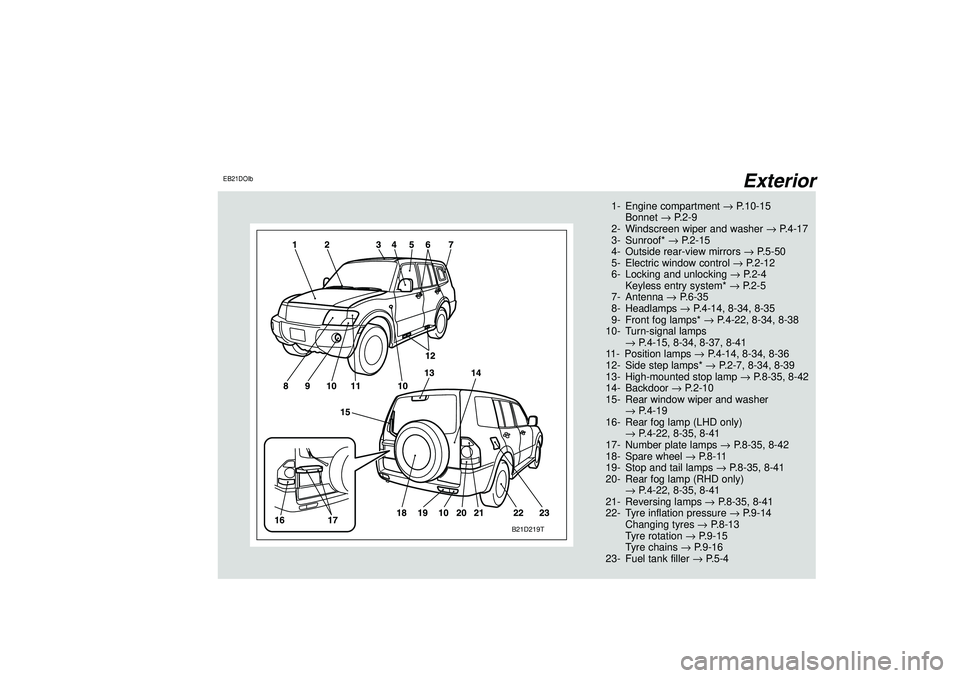
Exterior
EB21DOIb
B21D219T
1- Engine compartment→P.10-15
Bonnet→P.2-9
2- Windscreen wiper and washer→P.4-17
3- Sunroof*→P.2-15
4- Outside rear-view mirrors→P.5-50
5- Electric window control→P.2-12
6- Locking and unlocking→P.2-4
Keyless entry system*→P.2-5
7- Antenna→P.6-35
8- Headlamps→P.4-14, 8-34, 8-35
9- Front fog lamps*→P.4-22, 8-34, 8-38
10- Turn-signal lamps
→P.4-15, 8-34, 8-37, 8-41
11- Position lamps→P.4-14, 8-34, 8-36
12- Side step lamps*→P.2-7, 8-34, 8-39
13- High-mounted stop lamp→P.8-35, 8-42
14- Backdoor→P.2-10
15- Rear window wiper and washer
→P.4-19
16- Rear fog lamp (LHD only)
→P.4-22, 8-35, 8-41
17- Number plate lamps→P.8-35, 8-42
18- Spare wheel→P.8-11
19- Stop and tail lamps→P.8-35, 8-41
20- Rear fog lamp (RHD only)
→P.4-22, 8-35, 8-41
21- Reversing lamps→P.8-35, 8-41
22- Tyre inflation pressure→P.9-14
Changing tyres→P.8-13
Tyre rotation→P.9-15
Tyre chains→P.9-16
23- Fuel tank filler→P.5-4
Div:
Out put date:
Page 13 of 392
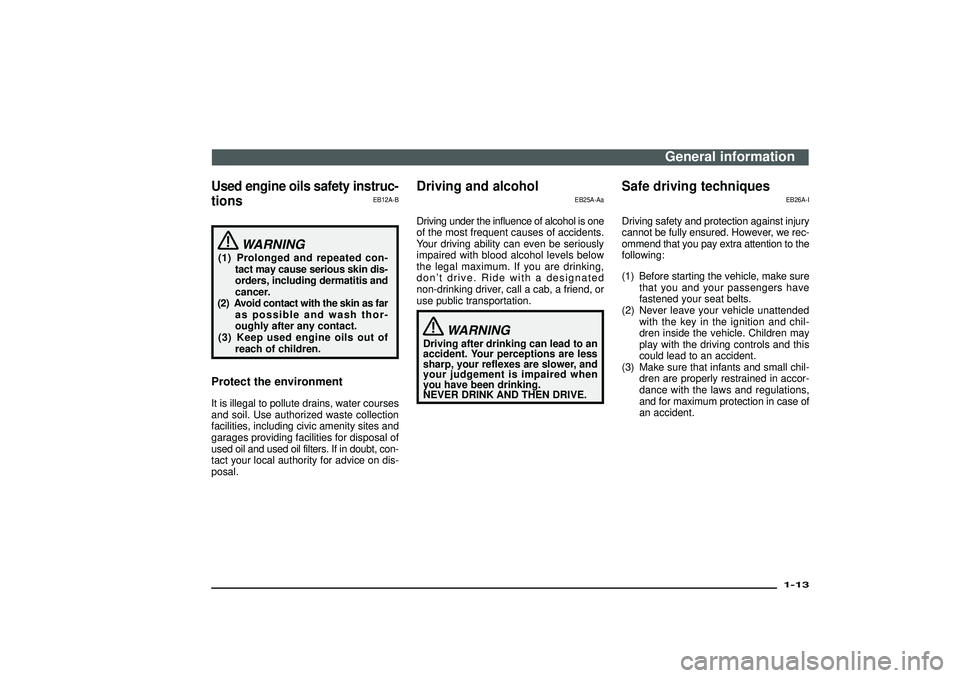
Used engine oils safety instruc-
tions
EB12A-B
WARNING
(1) Prolonged and repeated con-
tact may cause serious skin dis-
orders, including dermatitis and
cancer.
(2) Avoid contact with the skin as far
as possible and wash thor-
oughly after any contact.
(3) Keep used engine oils out of
reach of children.Protect the environmentIt is illegal to pollute drains, water courses
and soil. Use authorized waste collection
facilities, including civic amenity sites and
garages providing facilities for disposal of
used oil and used oil filters. If in doubt, con-
tact your local authority for advice on dis-
posal.
Driving and alcohol
EB25A-Aa
Driving under the influence of alcohol is one
of the most frequent causes of accidents.
Your driving ability can even be seriously
impaired with blood alcohol levels below
the legal maximum. If you are drinking,
don’t drive. Ride with a designated
non-drinking driver, call a cab, a friend, or
use public transportation.
WARNING
Driving after drinking can lead to an
accident. Your perceptions are less
sharp, your reflexes are slower, and
your judgement is impaired when
you have been drinking.
NEVER DRINK AND THEN DRIVE.
Safe driving techniques
EB26A-I
Driving safety and protection against injury
cannot be fully ensured. However, we rec-
ommend that you pay extra attention to the
following:
(1) Before starting the vehicle, make sure
that you and your passengers have
fastened your seat belts.
(2) Never leave your vehicle unattended
with the key in the ignition and chil-
dren inside the vehicle. Children may
play with the driving controls and this
could lead to an accident.
(3) Make sure that infants and small chil-
dren are properly restrained in accor-
dance with the laws and regulations,
and for maximum protection in case of
an accident.
General information
1-13
Div:
Out put date:
Page 14 of 392
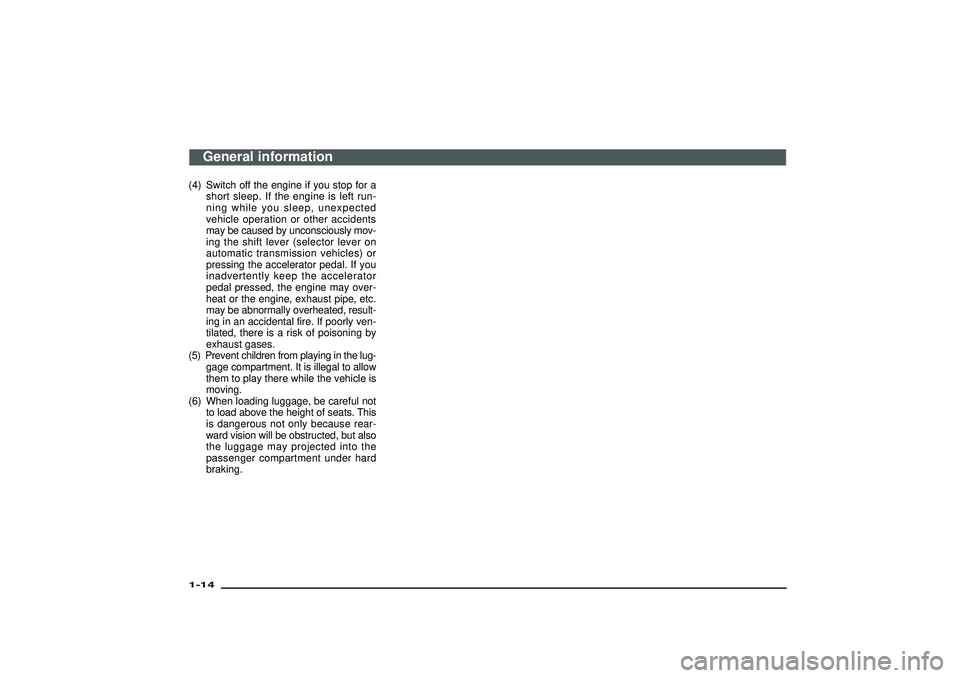
(4) Switch off the engine if you stop for a
short sleep. If the engine is left run-
ning while you sleep, unexpected
vehicle operation or other accidents
may be caused by unconsciously mov-
ing the shift lever (selector lever on
automatic transmission vehicles) or
pressing the accelerator pedal. If you
inadvertently keep the accelerator
pedal pressed, the engine may over-
heat or the engine, exhaust pipe, etc.
may be abnormally overheated, result-
ing in an accidental fire. If poorly ven-
tilated, there is a risk of poisoning by
exhaust gases.
(5) Prevent children from playing in the lug-
gage compartment. It is illegal to allow
them to play there while the vehicle is
moving.
(6) When loading luggage, be careful not
to load above the height of seats. This
is dangerous not only because rear-
ward vision will be obstructed, but also
the luggage may projected into the
passenger compartment under hard
braking.
General information
1-14Div:
Out put date:
Page 16 of 392
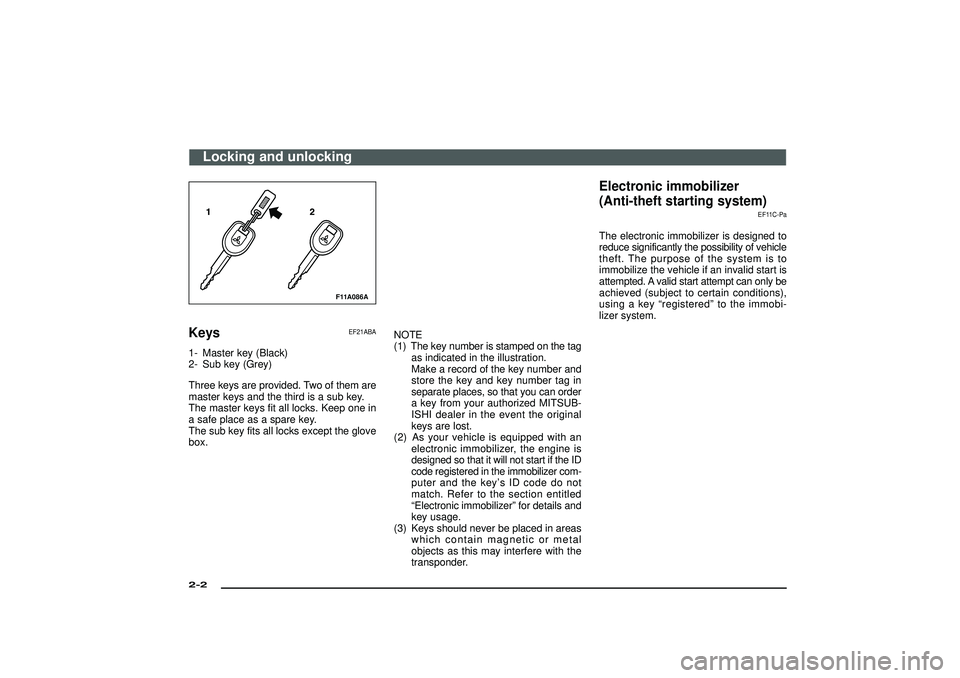
F11A086A
Keys
EF21ABA
1- Master key (Black)
2- Sub key (Grey)
Three keys are provided. Two of them are
master keys and the third is a sub key.
The master keys fit all locks. Keep one in
a safe place as a spare key.
The sub key fits all locks except the glove
box.NOTE
(1) The key number is stamped on the tag
as indicated in the illustration.
Make a record of the key number and
store the key and key number tag in
separate places, so that you can order
a key from your authorized MITSUB-
ISHI dealer in the event the original
keys are lost.
(2) As your vehicle is equipped with an
electronic immobilizer, the engine is
designed so that it will not start if the ID
code registered in the immobilizer com-
puter and the key’s ID code do not
match. Refer to the section entitled
“Electronic immobilizer” for details and
key usage.
(3) Keys should never be placed in areas
which contain magnetic or metal
objects as this may interfere with the
transponder.
Electronic immobilizer
(Anti-theft starting system)
EF11C-Pa
The electronic immobilizer is designed to
reduce significantly the possibility of vehicle
theft. The purpose of the system is to
immobilize the vehicle if an invalid start is
attempted. A valid start attempt can only be
achieved (subject to certain conditions),
using a key “registered” to the immobi-
lizer system.
Locking and unlocking
2-2Div:
Out put date:
Page 17 of 392
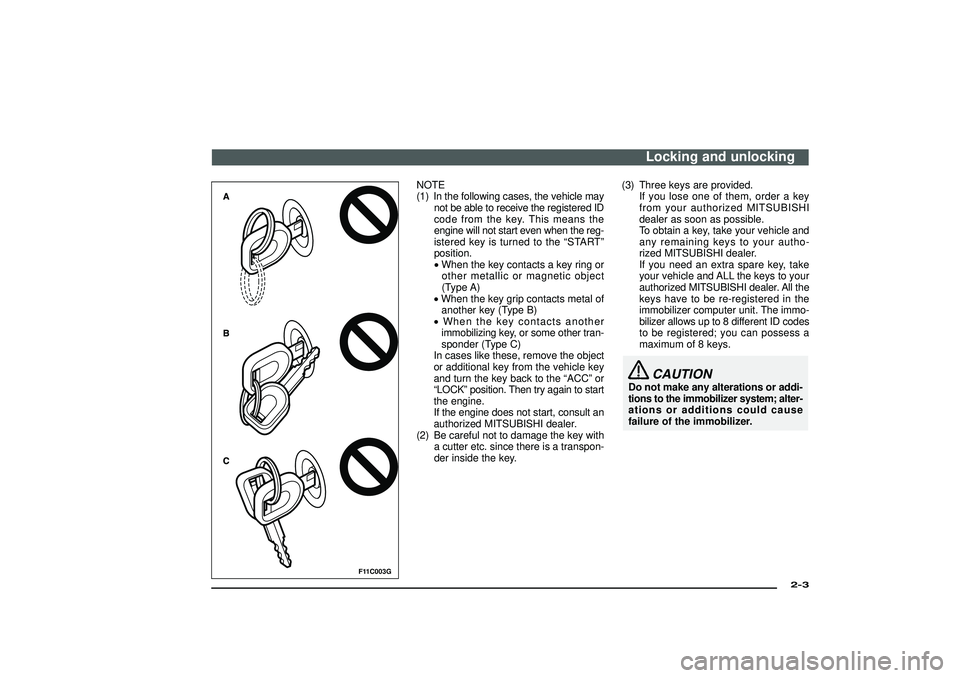
F11C003G
NOTE
(1) In the following cases, the vehicle may
not be able to receive the registered ID
code from the key. This means the
engine will not start even when the reg-
istered key is turned to the“START”
position.
•When the key contacts a key ring or
other metallic or magnetic object
(Type A)
•When the key grip contacts metal of
another key (Type B)
•When the key contacts another
immobilizing key, or some other tran-
sponder (Type C)
In cases like these, remove the object
or additional key from the vehicle key
and turn the key back to the“ACC”or
“LOCK”position. Then try again to start
the engine.
If the engine does not start, consult an
authorized MITSUBISHI dealer.
(2) Be careful not to damage the key with
a cutter etc. since there is a transpon-
der inside the key.(3) Three keys are provided.
If you lose one of them, order a key
from your authorized MITSUBISHI
dealer as soon as possible.
To obtain a key, take your vehicle and
any remaining keys to your autho-
rized MITSUBISHI dealer.
If you need an extra spare key, take
your vehicle and ALL the keys to your
authorized MITSUBISHI dealer. All the
keys have to be re-registered in the
immobilizer computer unit. The immo-
bilizer allows up to 8 different ID codes
to be registered; you can possess a
maximum of 8 keys.
CAUTION
Do not make any alterations or addi-
tions to the immobilizer system; alter-
ations or additions could cause
failure of the immobilizer.
Locking and unlocking
2-3
Div:
Out put date:
Page 27 of 392
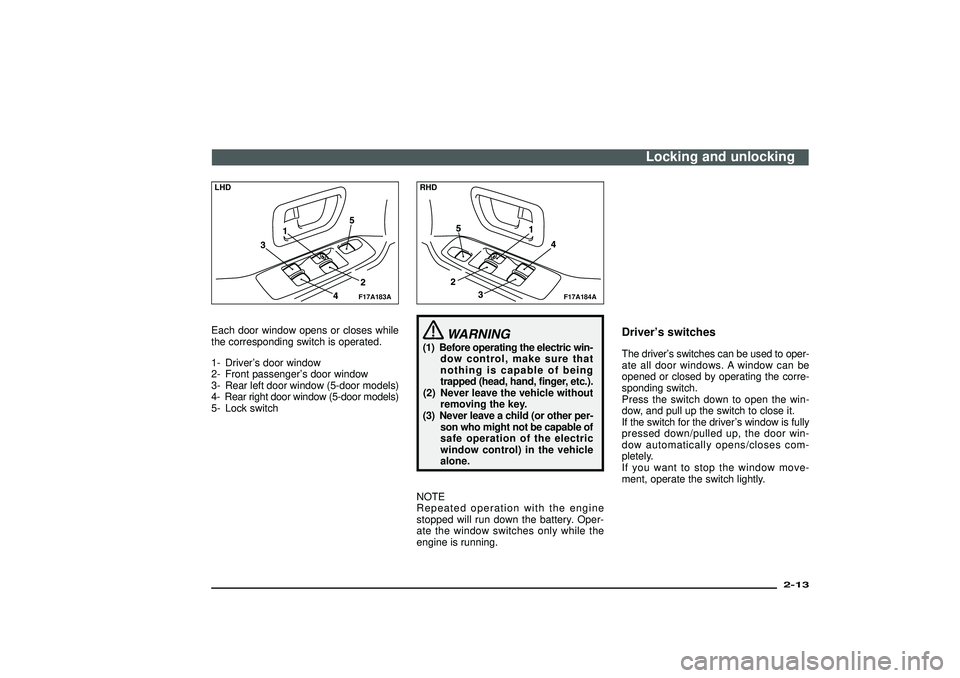
F17A183A
LHDEach door window opens or closes while
the corresponding switch is operated.
1- Driver’s door window
2- Front passenger’s door window
3- Rear left door window (5-door models)
4- Rear right door window (5-door models)
5- Lock switch
F17A184A
RHD
WARNING
(1) Before operating the electric win-
dow control, make sure that
nothing is capable of being
trapped (head, hand, finger, etc.).
(2) Never leave the vehicle without
removing the key.
(3) Never leave a child (or other per-
son who might not be capable of
safe operation of the electric
window control) in the vehicle
alone.
NOTE
Repeated operation with the engine
stopped will run down the battery. Oper-
ate the window switches only while the
engine is running.
Driver’s switchesThe driver’s switches can be used to oper-
ate all door windows. A window can be
opened or closed by operating the corre-
sponding switch.
Press the switch down to open the win-
dow, and pull up the switch to close it.
If the switch for the driver’s window is fully
pressed down/pulled up, the door win-
dow automatically opens/closes com-
pletely.
If you want to stop the window move-
ment, operate the switch lightly.
Locking and unlocking
2-13
Div:
Out put date:
Page 32 of 392

NOTE
( 1) When leaving the vehicle unat-
tended, make sure you close the sun-
roof and remove the ignition key.
( 2) Do not try to operate the sunroof if it
is frozen closed (after snow fall or dur-
ing extreme cold).
( 3) Do not sit or place heavy luggage on
the sunroof or roof opening edge.
( 4) Release the switch as soon as the
sunroof reaches the fully open or fully
closed position.
( 5) If the sunroof does not operate when
the sunroof switch is operated,
release the switch and check whether
something is trapped by the sun-
roof. If nothing is trapped, have the
sunroof checked at an authorized
MITSUBISHI dealer.
( 6) Depending on the models of ski car-
riers or roof carriers, the sunroof may
contact with the carrier when the sun-
roof is tilted up. Be careful when tilt-
ing up the sunroof if such a ski carrier
or a roof carrier is installed.
( 7) Be sure to close the sunroof com-
pletely when washing the vehicle or
when leaving the vehicle.( 8) Be careful, not to put any wax on the
weatherstrip (black rubber) around the
sunroof opening. If stained with wax,
the weatherstrip cannot maintain a
weatherproof seal with the sunroof.
( 9) After washing the vehicle or after it
has rained, wipe off any water that is
on the sunroof before operating it.
(10) Operating the sunroof repeatedly with
the engine stationary will run down the
battery. Operate the sunroof while the
engine is running.
Locking and unlocking
2-18Div:
Out put date:
Page 95 of 392
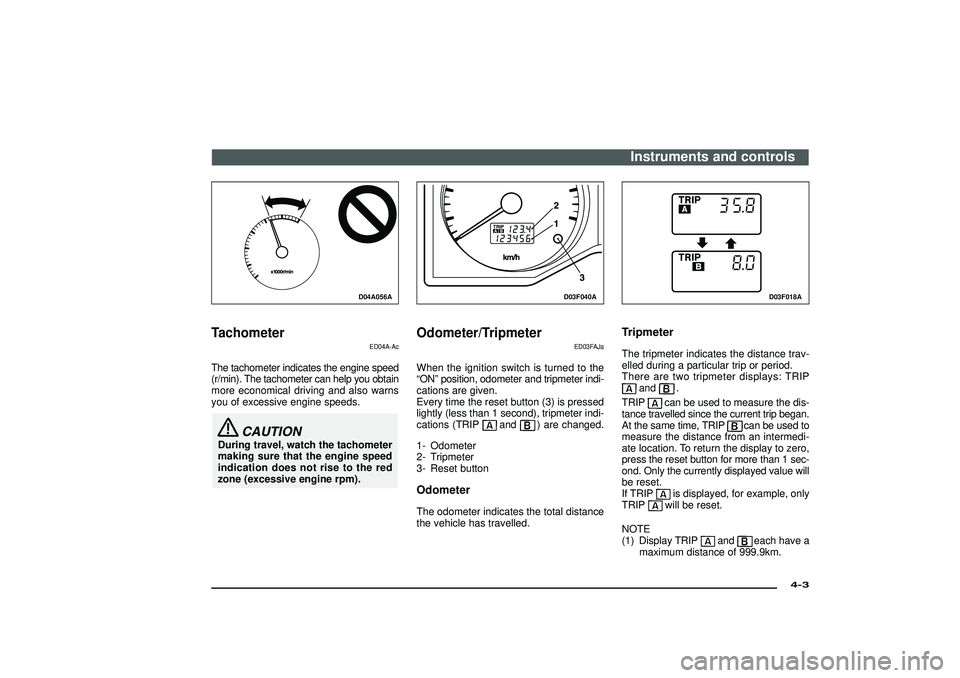
D04A056A
Tachometer
ED04A-Ac
The tachometer indicates the engine speed
(r/min). The tachometer can help you obtain
more economical driving and also warns
you of excessive engine speeds.
CAUTION
During travel, watch the tachometer
making sure that the engine speed
indication does not rise to the red
zone (excessive engine rpm).
D03F040A
Odometer/Tripmeter
ED03FAJa
When the ignition switch is turned to the
“ON”position, odometer and tripmeter indi-
cations are given.
Every time the reset button (3) is pressed
lightly (less than 1 second), tripmeter indi-
cations (TRIP
and
) are changed.
1- Odometer
2- Tripmeter
3- Reset button
OdometerThe odometer indicates the total distance
the vehicle has travelled.
D03F018A
TripmeterThe tripmeter indicates the distance trav-
elled during a particular trip or period.
There are two tripmeter displays: TRIP
and
.
TRIP
can be used to measure the dis-
tance travelled since the current trip began.
At the same time, TRIP
can be used to
measure the distance from an intermedi-
ate location. To return the display to zero,
press the reset button for more than 1 sec-
ond. Only the currently displayed value will
be reset.
If TRIP
is displayed, for example, only
TRIPwill be reset.
NOTE
(1) Display TRIP
and
each have a
maximum distance of 999.9km.
Instruments and controls
4-3
Div:
Out put date:
Page 97 of 392

D06A047A
Water temperature gauge
ED06A-Nb
The water temperature gauge indicates the
engine coolant temperature when the igni-
tion switch is“ON”.
CAUTION
If the indication needle enters the
zone “A” while the engine is run-
ning, it indicates that the engine is
possibly overheating. Immediately
park your vehicle in a safe place and
make the necessary corrections.
(Refer to “Engine overheating” on
page 8-21.)
While driving, care should always be
taken to maintain the normal operat-
ing temperature.
Instruments and controls
4-5
Div:
Out put date:
Page 98 of 392
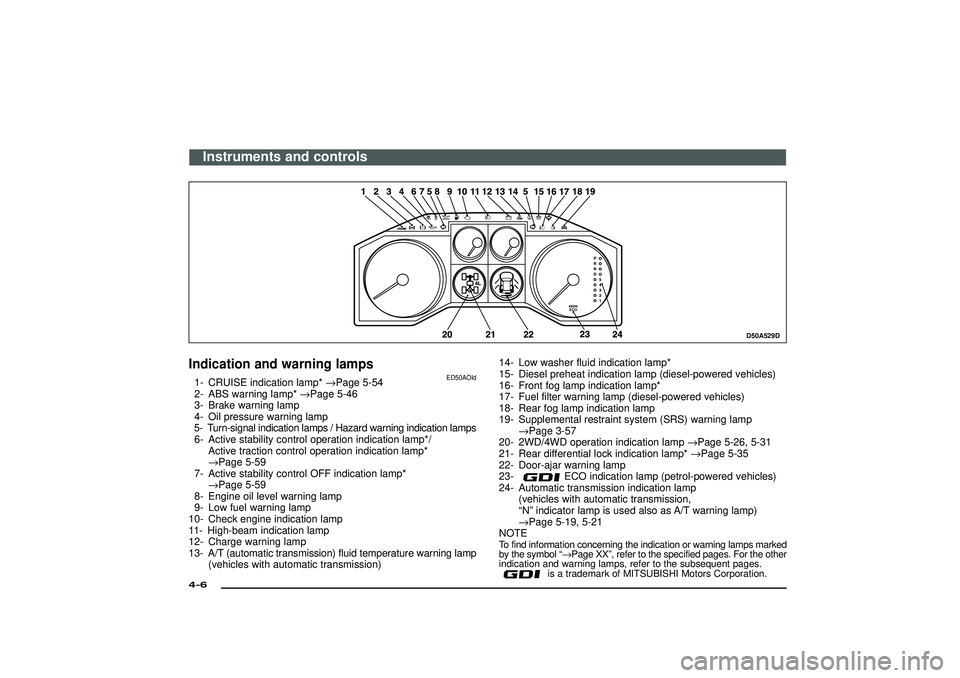
D50A529D
Indication and warning lamps
ED50AOId
1- CRUISE indication lamp*→Page 5-54
2- ABS warning lamp*→Page 5-46
3- Brake warning lamp
4- Oil pressure warning lamp
5- Turn-signal indication lamps / Hazard warning indication lamps
6- Active stability control operation indication lamp*/
Active traction control operation indication lamp*
→Page 5-59
7- Active stability control OFF indication lamp*
→Page 5-59
8- Engine oil level warning lamp
9- Low fuel warning lamp
10- Check engine indication lamp
11- High-beam indication lamp
12- Charge warning lamp
13- A/T (automatic transmission) fluid temperature warning lamp
(vehicles with automatic transmission)14- Low washer fluid indication lamp*
15- Diesel preheat indication lamp (diesel-powered vehicles)
16- Front fog lamp indication lamp*
17- Fuel filter warning lamp (diesel-powered vehicles)
18- Rear fog lamp indication lamp
19- Supplemental restraint system (SRS) warning lamp
→Page 3-57
20- 2WD/4WD operation indication lamp→Page 5-26, 5-31
21- Rear differential lock indication lamp*→Page 5-35
22- Door-ajar warning lamp
23-
ECO indication lamp (petrol-powered vehicles)
24- Automatic transmission indication lamp
(vehicles with automatic transmission,
“N”indicator lamp is used also as A/T warning lamp)
→Page 5-19, 5-21
NOTE
To find information concerning the indication or warning lamps marked
by the symbol“→Page XX”, refer to the specified pages. For the other
indication and warning lamps, refer to the subsequent pages.
is a trademark of MITSUBISHI Motors Corporation.
Instruments and controls
4-6Div:
Out put date: